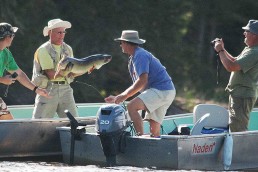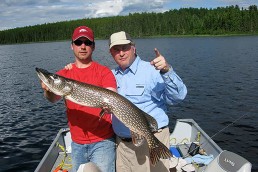Way Beyond a Chop: Rainbows love Lake Michigan Waves
The Lake Michigan waves had built from choppy 2- to 3-footers, and by the look of things, this was going to be a short trip. My cousin Ken and I were about eight miles off Milwaukee when we set out our lines. The first hit came on a portside planer board trailing leadcore line. Along with the bouncing rod, you could see a beautiful silvery fish jumping clear of the waves. I fought and netted the fish, a sleek 7-pound rainbow trout. Kenny’s 18-foot Alumacraft was bouncing around like a cork in a washing machine, and you had to keep a hand on the wheel at all times! We fished for another two hours or so, before determining we had all the fun we could stand for one day. We motored back into South Shore with three silvery rainbow trout in the cooler. Our short, rough water trip had yielded a seven- and an eight-pound fish, as well as massive 17-1/2-pound rainbow that lay in the cooler.
Like a lot of “big pond” anglers, I’ve always kept notes to help determine what does and does not work on Lake Michigan. Once summer temperatures warm the water and thermoclines set up, rainbow trout will often feed slightly higher in the water column than salmon. Rainbows are often found way off shore in Lake Michigan, and I have noticed that they seem to love to feed in rough, choppy water. They have a well-deserved reputation for, and are often regarded as, the most boat shy and wary of the Lake Michigan salmonids. It’s pretty much standard operating procedure to run lines targeting the big trout on boards or flat lines runs way back, away from the boat. Open-water, roaming rainbows often pick food from the surface, as evidenced by stomach contents like June bugs and butterflies found in the big trout.
My theory is the rough water gives the fish a feeling of security, as the chop breaks up the surface and limits light penetration. The wind also moves food around, and out into the rainbow’s offshore feeding zone. We borrow a trick from salt-water anglers and look for gulls feeding on dead floating baitfish. Food like dead or wounded baitfish and insects often form floating “scum lines” and finding one out in open water can be the key to finding trout. Work your lines in and out of the line in an “S” pattern. Another idea that has paid off is setting lines at or just above a temperature break. Even a change of a few degrees can make a difference. Use GPS or landmarks to stay in an area where you find fish. Even though they are roaming open water, rainbows often form schools, and where you find one fish, you are likely to find more. Sometimes lone pieces of structure in the middle of nowhere will hold baitfish. Mark that spot, and visit it during prime rainbow fishing conditions. We have a shipwreck off Milwaukee marked for just such occasions.
When working that upper one-third of the water column for rainbows, set lines as shallow as 10 feet down. Run long lengths of line between the downrigger ball and bait. Planner boards should be set out and back, usually with lead core line. Reliable “bread and butter” rainbow baits include the fly-and-dodger combinations, especially ones using a chrome dodger. Troll diving crank baits in blue/silver or green/silver, along with smaller versions of plugs like J-Plugs and spoons like Slammers. Be sure to set out glow-in-the-dark colors during low-light periods and on cloudy, overcast days. We like to set out a mix of colors, and let the fish pick out their favorites. For example, all three of the trout taken on the trip mentioned in the beginning of the article were taken on Bloody Nose pattern Slammers. By the end of the trip, we had all four of that pattern of Slammer we had, out for trout.
Please use common sense. Don’t push the safety envelope for your boat, as no fish is worth your life. I recommend wearing your life jacket when fishing rough water, especially when leaning over to net fish or set lines. If you can safely venture out in rough conditions, target those oversize Lake Michigan rainbows. You may be pleasantly surprised by the results.
MWO
SHARE THIS POST
You may also like...
Did you enjoy this post?
You can be among the first to get the latest info on where to go, what to use and how to use it!
Ron Stresing
Ron Stresing has fished since age 4 and hunted since age 12, with a lifelong passion for both. He tries to convey the lessons learned over a lifetime of hunting and fishing in Wisconsin. He also writes a column on shotguns for On Wisconsin Outdoors.



